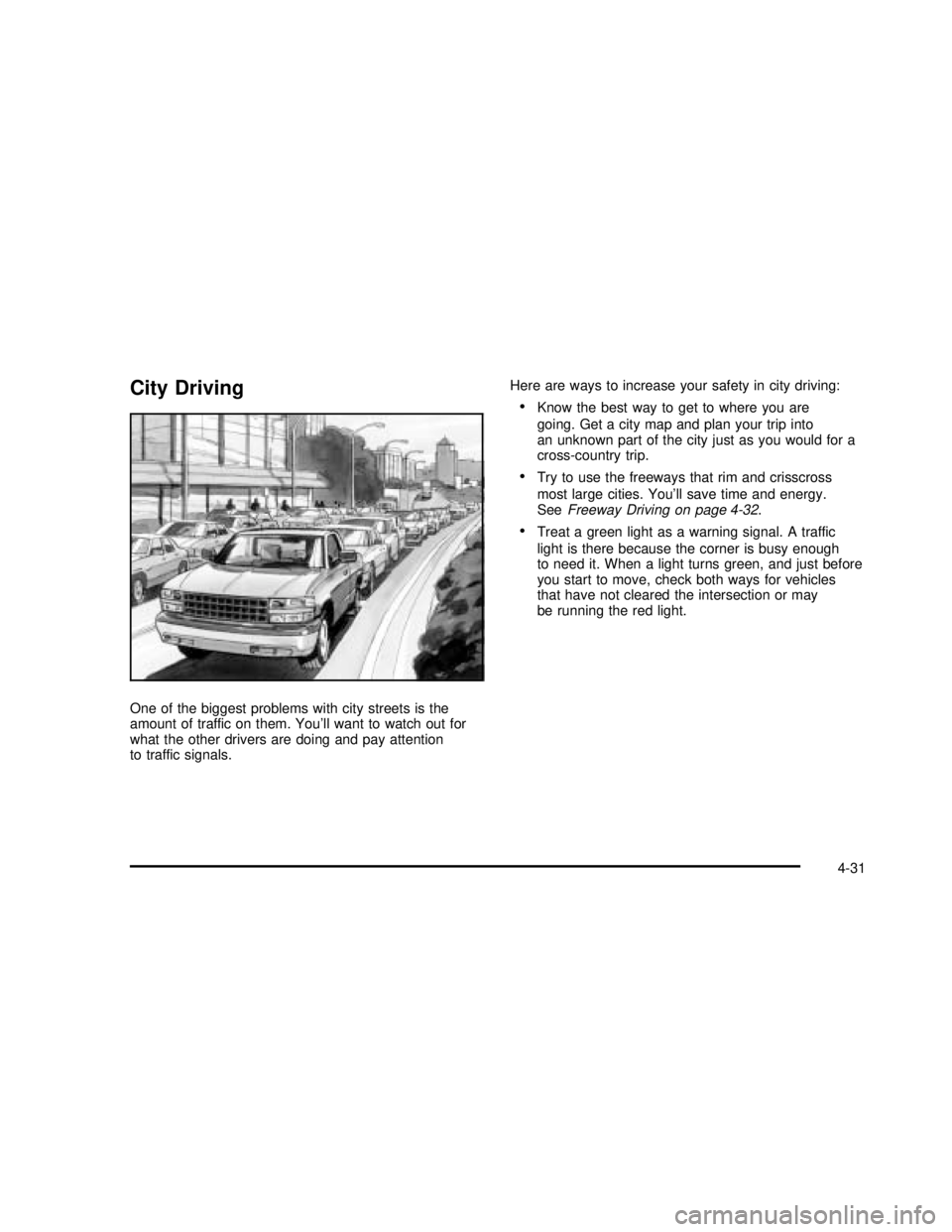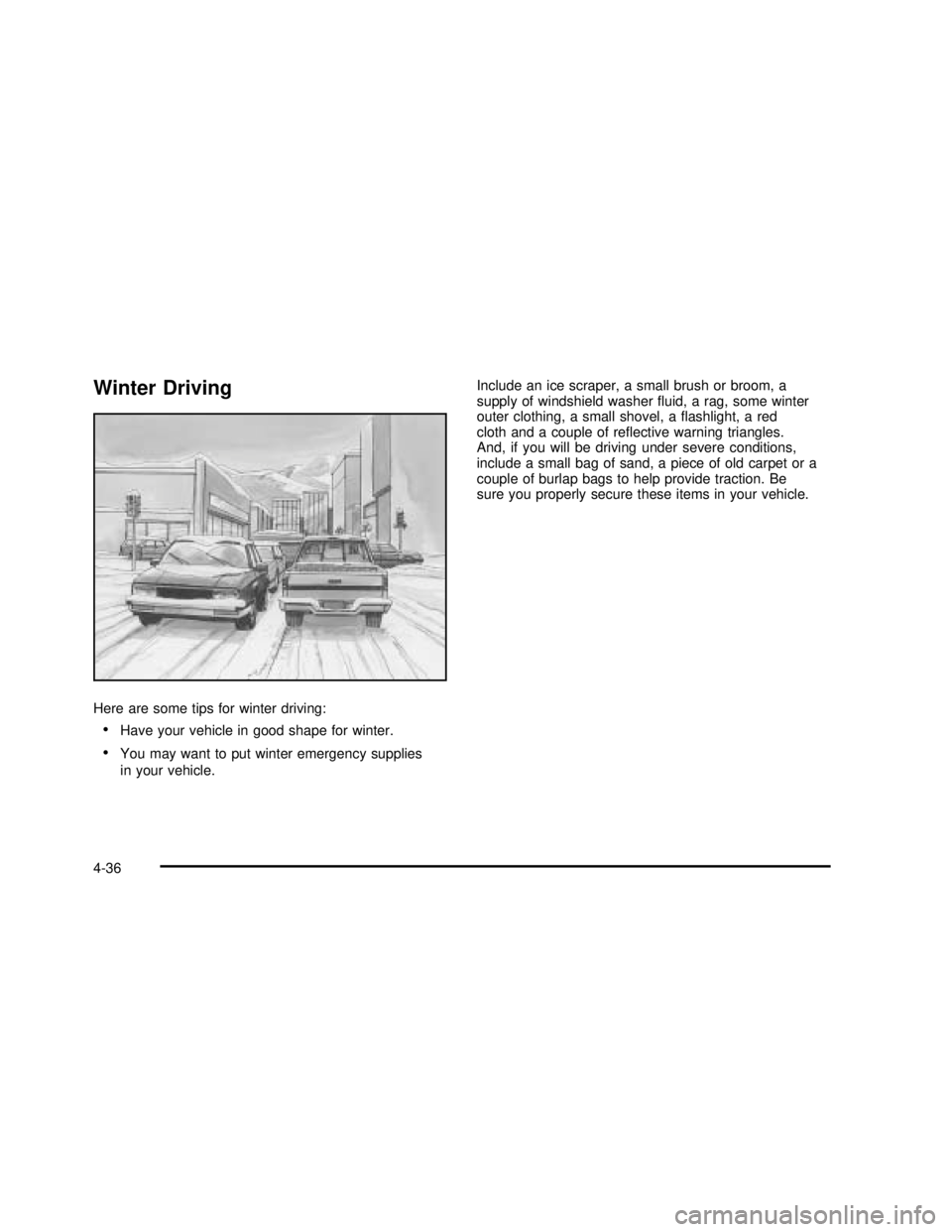warning light GMC SONOMA 2003 User Guide
[x] Cancel search | Manufacturer: GMC, Model Year: 2003, Model line: SONOMA, Model: GMC SONOMA 2003Pages: 424, PDF Size: 2.45 MB
Page 163 of 424

Fuel Gage
When the ignition is on, the fuel gage tells you about
how much fuel you have remaining.
Here are four things that some owners ask about.
None of these show a problem with your fuel gage:
At the gas station, the gas pump shuts off before the
gage reads full.
It takes a little more or less fuel to�ll up than the
gage indicated. For example, the gage may have
indicated the tank was half full, but it actually took a
little more or less than half the tank’s capacity to
�ll the tank.
The gage moves a little when you turn a corner or
speed up.
The gage doesn’t go back to empty when you turn
off the ignition.
Low Fuel Warning Light
This light comes on
brie�y when you start
your engine.
This light comes on when the fuel tank is low on fuel.
To turn if off, add fuel to the fuel tank. SeeFilling Your
Tank on page 5-6. United States
Canada
3-35
2003 - Sonoma OM
Page 204 of 424

If you keep pace with the traffic and allow realistic
following distances, you will eliminate a lot of
unnecessary braking. That means better braking and
longer brake life.
If your engine ever stops while you’re driving, brake
normally but don’t pump your brakes. If you do,
the pedal may get harder to push down. If your engine
stops, you will still have some power brake assist.
But you will use it when you brake. Once the power
assist is used up, it may take longer to stop and
the brake pedal will be harder to push.
Anti-lock Brake System
Your vehicle has anti-lock brakes. ABS is an advanced
electronic braking system that will help prevent a
braking skid.
When you start your engine and begin to drive away,
your anti-lock brake system will check itself. You
may hear a momentary motor or clicking noise while
this test is going on. This is normal.
If there’s a problem with
the anti-lock brake system,
this warning light will
stay on. SeeAnti-Lock
Brake System Warning
Light on page 3-28.Let’s say the road is wet and you’re driving safely.
Suddenly, an animal jumps out in front of you. You slam
on the brakes and continue braking. Here’s what
happens with ABS:
A computer senses that wheels are slowing down. If
one of the wheels is about to stop rolling, the computer
will separately work the brakes at each front wheel
and at both rear wheels.
4-6
2003 - Sonoma OM
Page 228 of 424

Hydroplaning
Hydroplaning is dangerous. So much water can build up
under your tires that they can actually ride on the
water. This can happen if the road is wet enough and
you’re going fast enough. When your vehicle is
hydroplaning, it has little or no contact with the road.
Hydroplaning doesn’t happen often. But it can if
your tires do not have much tread or if the pressure in
one or more is low. It can happen if a lot of water is
standing on the road. If you can see re�ections
from trees, telephone poles or other vehicles, and
raindrops“dimple”the water’s surface, there could be
hydroplaning.
Hydroplaning usually happens at higher speeds.
There just isn’t a hard and fast rule about hydroplaning.
The best advice is to slow down when it is raining.
Driving Through Deep Standing Water
Notice:If you drive too quickly through deep
puddles or standing water, water can come in
through your engine’s air intake and badly damage
your engine.Never drive through water that is
slightly lower than the underbody of your vehicle.
If you can’t avoid deep puddles or standing
water, drive through them very slowly.
Driving Through Flowing Water
{CAUTION:
Flowing or rushing water creates strong forces.
If you try to drive through flowing water, as you
might at a low water crossing, your vehicle can
be carried away.As little as six inches of
flowing water can carry away a smaller vehicle.
If this happens, you and other vehicle
occupants could drown.Don’t ignore police
warning signs, and otherwise be very cautious
about trying to drive through flowing water.
Some Other Rainy Weather Tips
Besides slowing down, allow some extra following
distance. And be especially careful when you
pass another vehicle. Allow yourself more clear
room ahead, and be prepared to have your
view restricted by road spray.
Have good tires with proper tread depth.
SeeTires on page 5-58.
4-30
2003 - Sonoma OM
Page 229 of 424

City Driving
One of the biggest problems with city streets is the
amount of traffic on them. You’ll want to watch out for
what the other drivers are doing and pay attention
to traffic signals.Here are ways to increase your safety in city driving:
Know the best way to get to where you are
going. Get a city map and plan your trip into
an unknown part of the city just as you would for a
cross-country trip.
Try to use the freeways that rim and crisscross
most large cities. You’ll save time and energy.
SeeFreeway Driving on page 4-32.
Treat a green light as a warning signal. A traffic
light is there because the corner is busy enough
to need it. When a light turns green, and just before
you start to move, check both ways for vehicles
that have not cleared the intersection or may
be running the red light.
4-31
2003 - Sonoma OM
Page 234 of 424

Winter Driving
Here are some tips for winter driving:
Have your vehicle in good shape for winter.
You may want to put winter emergency supplies
in your vehicle.Include an ice scraper, a small brush or broom, a
supply of windshield washer�uid, a rag, some winter
outer clothing, a small shovel, a�ashlight, a red
cloth and a couple of re�ective warning triangles.
And, if you will be driving under severe conditions,
include a small bag of sand, a piece of old carpet or a
couple of burlap bags to help provide traction. Be
sure you properly secure these items in your vehicle.
4-36
2003 - Sonoma OM
Page 283 of 424

How to Check and Add Fluid
The properfluid should be added if the level does not
reach the bottom of the diaphragm when it’s in place
in the reservoir. See the instructions on the
reservoir cap.
Engine Coolant
The cooling system in your vehicle isfilled with
DEX-COOL®engine coolant. This coolant is designed
to remain in your vehicle for 5 years or 150,000 miles
(240 000 km), whichever occursfirst, if you add
only DEX-COOL
®extended life coolant.
The following explains your cooling system and how to
add coolant when it is low. If you have a problem
with engine overheating, seeEngine Overheating
on page 5-28.A 50/50 mixture of clean, drinkable water and
DEX-COOL
®coolant will:
•Give freezing protection down to−34°F(−37°C).
•Give boiling protection up to 265°F (129°C).
•Protect against rust and corrosion.
•Help keep the proper engine temperature.
•Let the warning lights and gages work as
they should.
Notice:When adding coolant, it is important that
you use only DEX-COOL
®(silicate-free) coolant.
If coolant other than DEX-COOL®is added to
the system, premature engine, heater core or
radiator corrosion may result. In addition, the engine
coolant will require change sooner -- at 30,000 miles
(50,000 km) or 24 months, whichever occurs�rst.
Damage caused by the use of coolant other
than DEX-COOL
®is not covered by your new
vehicle warranty.
5-25
2003 - Sonoma OM
Page 299 of 424

Brake Wear
If you have four-wheel drive, your vehicle has four-wheel
disc brakes. If not, your vehicle has front disc brakes
and rear drum brakes.
Disc brake pads have built-in wear indicators that make
a high-pitched warning sound when the brake pads
are worn and new pads are needed. The sound
may come and go or be heard all the time your vehicle
is moving (except when you are pushing on the
brake pedalfirmly).
{CAUTION:
The brake wear warning sound means that
soon your brakes won’t work well. That could
lead to an accident. When you hear the brake
wear warning sound, have your vehicle
serviced.
Notice:Continuing to drive with worn-out brake
pads could result in costly brake repair.
Some driving conditions or climates may cause a brake
squeal when the brakes arefirst applied or lightly applied.
This does not mean something is wrong with your brakes.Properly torqued wheel nuts are necessary to help
prevent brake pulsation. When tires are rotated, inspect
brake pads for wear and evenly tighten wheel nuts in
the proper sequence to GM torque specifications.
If you have rear drum brakes, they don’t have wear
indicators, but if you ever hear a rear brake rubbing
noise, have the rear brake linings inspected immediately.
Also, the rear brake drums should be removed and
inspected each time the tires are removed for rotation or
changing. When you have the front brake pads
replaced, have the rear brakes inspected, too.
Brake linings should always be replaced as complete
axle sets.
SeeBrake System Inspection on page 6-32.Brake Pedal Travel
See your dealer if the brake pedal does not return to
normal height, or if there is a rapid increase in
pedal travel. This could be a sign of brake trouble.
Brake Adjustment
Every time you make a brake stop, your disc brakes
adjust for wear.
If you don’t have four-wheel drive and your brake
pedal goes down farther than normal, your rear drum
brakes may need adjustment. Adjust them by backing
up andfirmly applying the brakes a few times.
5-41
2003 - Sonoma OM
Page 321 of 424

Uniform Tire Quality Grading
Quality grades can be found where applicable on the
tire sidewall between tread shoulder and maximum
section width. For example:
Treadwear 200 Traction AA Temperature A
The following information relates to the system
developed by the United States National Highway
Traffic Safety Administration, which grades tires by
treadwear, traction and temperature performance.
(This applies only to vehicles sold in the United States.)
The grades are molded on the sidewalls of most
passenger car tires. The Uniform Tire Quality Grading
system does not apply to deep tread, winter-type
snow tires, space-saver or temporary use spare tires,
tires with nominal rim diameters of 10 to 12 inches
(25 to 30 cm), or to some limited-production tires.
While the tires available on General Motors passenger
cars and light trucks may vary with respect to these
grades, they must also conform to federal safety
requirements and additional General Motors Tire
Performance Criteria (TPC) standards.
Treadwear
The treadwear grade is a comparative rating based on
the wear rate of the tire when tested under controlled
conditions on a specified government test course.
For example, a tire graded 150 would wear one and
a half (1.5) times as well on the government course as
a tire graded 100. The relative performance of tires
depends upon the actual conditions of their use,
however, and may depart significantly from the norm
due to variations in driving habits, service practices and
differences in road characteristics and climate.
Traction–AA, A, B, C
The traction grades, from highest to lowest, are AA, A,
B, and C. Those grades represent the tire’s ability
to stop on wet pavement as measured under controlled
conditions on specified government test surfaces of
asphalt and concrete. A tire marked C may have poor
traction performance. Warning: The traction grade
assigned to this tire is based on straight-ahead braking
traction tests, and does not include acceleration,
cornering, hydroplaning, or peak traction characteristics.
5-63
2003 - Sonoma OM
Page 403 of 424

A
Accessory Power Outlets.................................3-15
Adding Equipment to Your Air Bag-Equipped
Vehicle.......................................................1-63
Adding Washer Fluid.......................................5-38
Additional Program Information........................... 7-8
Additives, Fuel................................................. 5-5
Add-On Electrical Equipment............................5-88
Add-On Equipment..........................................4-48
Adjusting the Speakers
(Balance/Fade)....................3-39, 3-42, 3-49, 3-59
After Off-Road Driving.....................................4-26
Air Bag
Off Light.....................................................3-24
Readiness Light..........................................3-24
Air Bag System..............................................1-54
Adding Equipment to Your Air Bag-Equipped
Vehicle...................................................1-63
Air Bag Off Switch.......................................1-60
How Does an Air Bag Restrain?....................1-58
Servicing Your Air Bag-Equipped Vehicle.........1-63
What Makes an Air Bag Inflate?....................1-58
What Will You See After an Air Bag
Inflates?..................................................1-58
When Should an Air Bag Inflate?...................1-57
Where Are the Air Bags?..............................1-56
Air Cleaner/Filter, Engine.................................5-18
All Overseas Locations...................................... 7-4Aluminum Wheels...........................................5-84
AM ...............................................................3-67
AM-FM Radio.................................................3-37
Antenna, Fixed Mast.......................................3-69
Anti-Lock Brake System.................................... 4-6
Anti-Lock Brake, System Warning Light..............3-28
Appearance Care............................................5-79
Care of Safety Belts....................................5-82
Chemical Paint Spotting...............................5-85
Cleaning the Inside of Your Vehicle................5-79
Cleaning the Outside of Your Vehicle..............5-82
Finish Damage............................................5-85
GM Vehicle Care/Appearance Materials..........5-86
Sheet Metal Damage...................................5-85
Underbody Maintenance
...............................5-85
Weatherstrips
..............................................5-82
Approaching a Hill
..........................................4-18
Ashtrays
........................................................3-16
Assist Handles
...............................................2-50
Audio System(s)
.............................................3-36
AM-FM Radio
.............................................3-37
Care of Your Cassette Tape Player
................3-68
Care of Your CD Player
...............................3-69
Care of Your CDs
........................................3-69
Fixed Mast Antenna
.....................................3-69
Radio with Cassette and CD
.........................3-47
Radio with CD
............................................3-40
Radio with Six-Disc CD
................................3-56
1
2003 - Sonoma OM
Page 404 of 424

Audio System(s) (cont.)
Setting the Time for Radios with Radio
Data Systems (RDS)................................3-37
Setting the Time for Radios without Radio
Data Systems (RDS)................................3-36
Theft-Deterrent Feature................................3-67
Understanding Radio Reception.....................3-67
Automatic Headlamp System............................3-11
Automatic Transmission...................................2-22
Fluid..........................................................5-20
Operation...................................................2-25
Automatic Transmission Check..........................6-27
Automatic Transmission Shift Lock Control
System Check.............................................6-29
B
Backing Up....................................................4-58
Battery..........................................................5-42
Battery Replacement......................................... 2-6
Battery Rundown Protection.............................3-15
Bed Rails......................................................2-52
Before Leaving on a Long Trip.........................4-33
Before You Go Off-Roading..............................4-13
Body Lubrication Service..................................6-28
Brake
Parking......................................................2-32
System Inspection.......................................6-32Brake (cont.)
System Warning Light..................................3-27
Brake Adjustment............................................5-41
Brake Fluid....................................................5-39
Brake Pedal Travel.........................................5-41
Brake Wear...................................................5-41
Brakes..........................................................5-39
Braking........................................................... 4-5
Braking in Emergencies..................................... 4-7
Break-In, New Vehicle.....................................2-20
Bulb Replacement...........................................5-50
Center High-Mounted Stoplamp (CHMSL)........5-54
Halogen Bulbs............................................5-50
Headlamps.................................................5-50
One-Piece Front Turn Signal Lamps...............5-52
Replacement Bulbs......................................5-55
Taillamps....................................................5-55
Two-Piece Front Turn Signal Lamps...............5-53
Buying New Tires...........................................5-62
C
California Fuel.................................................. 5-5
Canada........................................................... 7-4
Canadian Owners................................................ ii
Canadian Roadside Assistance........................... 7-6
Capacities and Specifications............................5-94
Carbon Monoxide...................4-36, 4-51, 2-12, 2-37
2
2003 - Sonoma OM